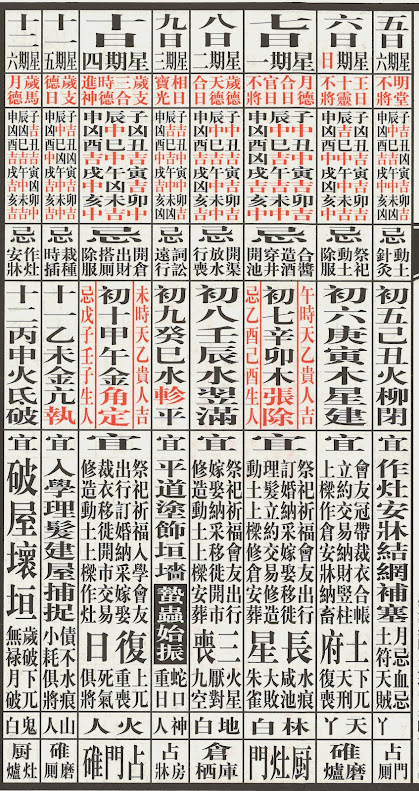Click here for the introduction to the Round and Square series "Calendars and Almanacs"
⇦⇦⇦⇦⇦ From right to left: ⇦⇦⇦⇦
2/12..............................................................................................................................................2/5
2/12..............................................................................................................................................2/5
This is one in a never-ending series—following the movements of the calendar—in Round and Square perpetuity. It is today's date in the Chinese lunar-solar (or "luni-solar" calendar; I call it the "lunar" calendar in order to distinguish it from the kinds of calendars most Westerners use. It has a basic translation and minimal interpretation.
As for interpreting the translation, unless you have been studying calendars (and Chinese culture) for many years, you will likely find yourself asking "what does that mean?" I would caution that "it" doesn't "mean" any one thing (almost any "it" you will see). There are clusters of meaning, and they require patience, reflection, careful reading, and, well, a little bit of ethnographic fieldwork. The best place to start is the introduction to "Calendars and Almanacs" on this blog. I teach a semester-long course on this topic and, trust me, it takes a little bit of time to get used to the lunar calendar. Some of the material is readily accessible; some of it is impenetrable, even after many years. And do not assume that people from China understand the traditional calendar particularly well, either. I have encountered confusion and furrowed brows for countless items in the calendar. It can seem "remote," in other words, from the world we live in these days, and yet it is printed anew every single year.
As time goes on, I will link all of the sections to lengthy background essays. This will take a while. In the meantime, take a look, read the introduction, and think about all o
f the questions that emerge from even a quick look at the calendar. You will likely find that several of the translations seem quite "fanciful" in English. I am simply trying to convey that they also sound fairly fanciful in Chinese.
Solar Calendar Date
(top to bottom, right to left)
八
日
二期星
Second Month Eighth Day
Tuesday, February 8
Section Two
Beneficent Stars
Beneficent Stars
(top to bottom, right to left)
合天歲
日德德
Generational Exemplarity
Heavenly Exemplarity
Linked Days
Section Three
Auspicious Hours
(top to bottom, right to left)
申辰甲
Auspicious Hours
(top to bottom, right to left)
申辰甲
凶中中
酉巳丑
吉吉吉
戌午寅
凶中吉
亥未卯
吉中吉
23:00-1:00 In-Between
1:00-3:00 Auspicious
3:00-5:00 Auspicious
5:00-7:00 Auspicious
7:00-9:00 In-Between
9:00-11:00 Auspicious
11:00-13:00 In-Between
13:00-15:00 In-Between
15:00-17:00 Inauspicious
17:00-19:00 Auspicious
19:00-21:00 Inauspicious
21:00-23:00 Auspicious
————
Section Four
Activities to Avoid
(top-to-bottom; right to left)
忌
行放開
行放開
喪水渠
Opening Irrigation Sluices
Putting-into Water
Mourning Visits
————
Section Five
Cosmological Information
Cosmological Information
初
八
壬
辰
水
翌
滿
Eighth Day (Twelfth Lunar Month)
Cyclical Day: renchen (29//60)
Phase (element): Water
"Constellation Personality" Cycle: Wings (27/28)
"Day Personality" Cycle: Fullness (3/12)
"Day Personality" Cycle: Fullness (3/12)
————
Section Six
Appropriate Activities
and Miscellaneous Information
(top-to-bottom; right to left)
宜
修嫁祭
造娶祀
動納祈
土采福
上移會
樑徙友
安開出
葬市行
喪三
九厭火
空對星
Appropriate Activities
Venerating Ancestors
Inquiring-into Fortune
Meeting Friends
Going Out (and about)
Marriage Alliances
Grain Payments
Moving Residences
Opening Markets
Repairing and Constructing
Moving Soil
Raising Beams
Positioning Graves
Three Mournings
Baleful Asterisms
Fire Star
Mutual Loathing
Nine Vacancies
————
Section Seven
Inauspicious Stars
(the Chinese should be read right to left)
Inauspicious Stars
(the Chinese should be read right to left)
白 地
White, Earth
————
Section Eight
Miscellaneous Items
倉
栖 庫
Granary
Perch, Storehouse


No comments:
Post a Comment